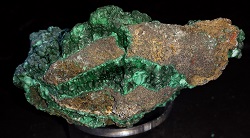A- |
B- |
C- |
D- |
E- |
F- |
G- |
H- |
I- |
J- |
K- |
L- |
M- |
N- |
O- |
P- |
Q- |
R- |
S- |
T- |
U- |
V- |
W- |
X- |
Y- |
Z |
MALACHITE:PHYSICAL CHARACTERISTICS:Color is banded light and dark green or (if crystalline), just dark green. Luster is dull in massive forms and silky as crystals. Transparency is opaque in massive form and translucent in crystalline forms. Crystal System is monoclinic; 2/m. Crystal Habitsin its massive forms are botryoidal, stalactitic or globular. Crystals are acicular or fibrous and form in tufts and encrustations. Frequently found as pseudomorphs of azurite. Cleavage is good in one direction but rarely seen. Fracture is conchoidal to splintery. Hardness is 3.5-4. Specific Gravity is 3.9+ (slightly heavy). Streak is green. Other Characteristics: Weakly effervesces in acid. Associated Minerals include limonite, chalcopyrite, bornite, native copper, calcite, cuprite, azurite, chrysocolla and many rare copper minerals such as kolwezite, shattuckite, antlerite, brochantite, graemite, aurichalcite, sphaerocobaltite, atacamite, chalcophyllite, conichalcite, rosasite, chalcosiderite, clinoclase, cornetite, duftite, libethenite, liroconite, mixite and mottramite among others. Notable Occurrences include many classic mineral localities such as Shaba, Congo; Tsumeb, Nambia; Ural mountains, Russia; Mexico; several sites in Australia; England and several localities in the Southwestern United States especially in Arizona, USA. Best Field Indicators are color banding, softness, associations and reaction to acid. Malachite is a famous and very popular semi-precious stone. It is named for the Greek word for "mallow", a green herb. Its banded light and dark green designs are one-of-a-kind, and give it a unique ornamental quality unlike that of any other stone. The light and dark green bands are so distinctive that malachite maybe one of the most easily recognized minerals by the general public. A popular design of ceramic ware which imitates this banding is named after the mineral malachite. It forms the banding from subtle changes in the oxidation states of the surrounding pore waters, but the exact mechanism is still not well understood. Tumbled stones of malachite are possibly the most popular tumbled stones ever and are sold in litterally every rock shop around the world. Carvings and figurines of malachite are almost as common. A skilled craftsman can make the concentric malachite bands follow the curves of a work of art like contours on a rugged terrain. Although malachite art is not as precious as jade; it is hard to argue that it is less beautiful. Malachite is also popular in jewelry, Native American Southwestern jewelry especially. The stones inlayed in silver make a nice variance from the traditional turquoise jewelry. Instead of competing, the two green stones tend to compliment each other when placed together in the same settings. Other stones such as coral, mother-of-pearl, azurite, jasper and onyx used in the typically handcrafted jewelry also compliment malachite's green colors. |

